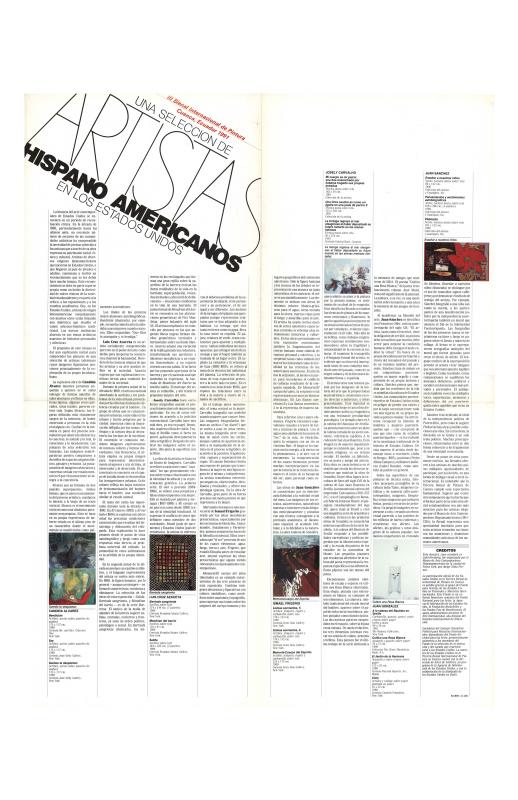Julia P. Herzberg is an art historian, independent curator, and Fulbright Senior Specialist living in New York. She completed her PhD in art history at the Graduate Center, City University of New York, in 1998, with a dissertation on Cuban artist Ana Mendieta. She is a specialist of Latin American artists living in the United States, and has curated more than twenty-five exhibitions. Herzberg was a co-curator of The Decade Show (1990), held in New York at the Museum of Contemporary Hispanic Art, the New Museum, and the Studio Museum in Harlem, and she was the curator of the official U.S. representation for the III Bienal Internacional de Pintura in Cuenca, Ecuador (1991). In addition to serving as a consulting curator at El Museo del Barrio in New York (1996–2001), she was a consulting curator for the 2003, 2006, and 2009 Bienales de La Habana and she is a contributing and consulting editor for Arte al día Internacional. Herzberg has taught, lectured, and published extensively in the United States and abroad and received two J. William Fulbright Scholarship Board awards: one at the Pontificia Universidad Católica (2007) and another at the Universidad Diego Portales (2013), both in Santiago, Chile, and also served as a visiting professor at the Instituto de Arte, Pontificia Universidad Católica de Valparaíso, Chile (2016).
The Decade Show took place from May to August 1990 across three New York contemporary art museums: the Studio Museum in Harlem, the New Museum of Contemporary Art, and the now-defunct MoCHA (Museum of Contemporary Hispanic Art, 1985–90), the latter two both located in Manhattan’s SoHo neighborhood. It included two hundred works by ninety-four U.S. artists of Asian, Hispanic, African, Native American, and European descent, and was co-curated by Herzberg herself (MoCHA), Laura Trippi and Gary Sangster (New Museum), and Sharon Patton (Studio Museum). The show included a broad array of media and perspectives, and was organized around six themes that were showcased at each of the museums: biography/autobiography and sexuality/gender (MoCHA), myth/spirituality/nature and discourse/media (New Museum), as well as social practices/cultural criticism and history/memory/artifact (Studio Museum).
Herzberg’s essay addresses the work of the artists of Latin American and Caribbean descent in the show, all of whom lived in the United States at the time, including: Cecilia Vicuña (b. 1948, Santiago, Chile), Ana Mendieta (b. 1948, Havana Cuba; d. 1985, New York, United States), Andres Serrano (b. 1950, New York, United States), Liliana Porter (b. 1941, Buenos Aires, Argentina), María Brito-Avellana (b. 1947, Havana, Cuba), Néstor Millán (b. 1960, San Germán Puerto Rico), Josely Carvalho (b. 1942, São Paulo, Brazil), Carlos Alfonzo (b. 1950, Havana, Cuba; d. 1991, Miami, United States), Arnaldo Roche (b. 1955, San Juan, Puerto Rico), Jorge Tacla (b. 1958, Santiago, Chile), Luis Cruz Azaceta (b. 1942, Havana, Cuba), Catalina Parra (b. 1940, Santiago, Chile), Judite dos Santos (b. Porto, Portugal), Juan Sánchez (b. 1954, Brooklyn, United States), Yolanda López (b. 1942, San Diego, United States), Luis Jiménez (b. 1940, El Paso, United States; d. 2006, Hondo, United States), Louis Bernal (b. 1941, Douglas, United States; d. 1993, Tucson, United States), Nick Quijano (b. 1953, New York, United States), John Ahearn (b. 1952, Binghamton, United States) and Rigoberto Torres (b. 1960, Aguadilla, Puerto Rico), Amalia Mesa-Bains (b. 1943, Santa Clara, United States), Max Aguilera-Hellweg (b. 1955, Fresno, United States), César Paternosto (b. 1931, La Plata, Argentina), Ismael Frigerio (b. 1955, Santiago, Chile), and Leandro Katz (b. 1938, Buenos Aires, Argentina).
The Decade Show was the first attempt to frame art of the 1980s through the lens of identity politics, with an increased attention to multiculturalism in art of the 1990s. It anticipated many issues that would continue to concern artists from that decade on, including the AIDS epidemic, mass media, as well as internationalism as the kernel of global art. It was also an ambitious capstone exhibition in MoCHA’s final year, with the museum closing abruptly in 1990 due to financial problems. [As a complementary reading, see another 1991 text in the ICAA Digital Archive that discusses some of the artists included in this show: “Una selección de artistas Hispano Americanos en los Estados Unidos” (doc. no. 1343847) by Julia Herzberg.]

